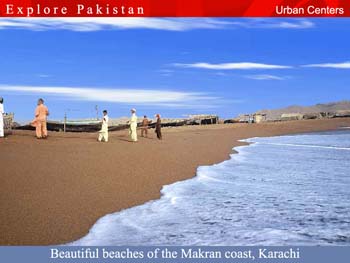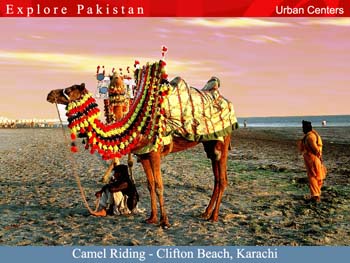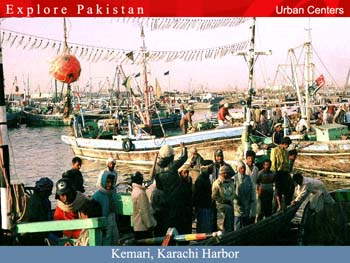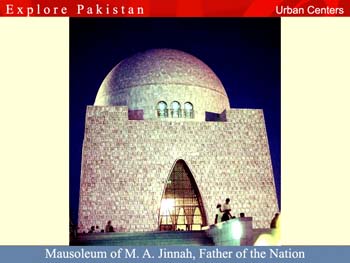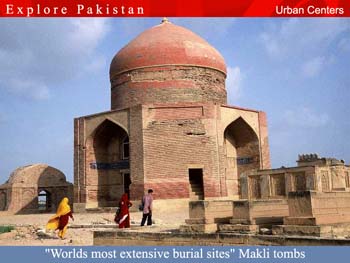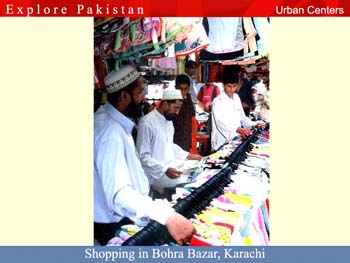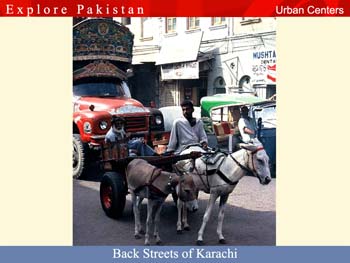|
KARACHI
Karachi started as a small fishing village called Mai KOLACHI. With the annexation of Sindhh by the British in 1843 it changed into a town. Its naturally protected harbour and moderate climate made it a summer resort for Sindhh. It was reputed to be the cleanest city of the sub-continent till 1947 with a population of 200,000. Karachi was transformed into an unmanageably big city with the establishment of Pakistan. It was the first capital of the federation from 1947 to 1960 before Islamabad was built. Being a port city millions of refugees from all over India streamed in here and gave it an unprecedented vitality and multicultural dimension. Today, its population exceeds 13 million. The main attractions of Karachi are the sea, the shopping and some fine specimen of Victorian architecture and modern buildings and international cuisine.
Karachi is the economic and commercial
capital of Pakistan and an important
regional port. It is located on the
coast of the Arabian Sea, northwest of
the Indus River delta. Karachi accounts
for the largest share of Pakistan's
gross domestic product and generates
about 65% of the national revenue.
Karachi claims the highest per capita
income in South Asia and is the nucleus
of regional business and technological
activities. The city has one of the
highest literacy rates in Pakistan and
is the home of several important
academic and research institutions.
Map of Karachi
Some basic facts about Karachi :
|
Province
|
Sindh |
|
Location
|
24°51′36″N, 67°00′36″E
|
|
Altitude
|
8
meters AMSL |
|
Area
|
3,527 km˛ |
|
Density
|
3,394 persons/km˛ |
|
Calling code
|
021 |
|
Time zone
|
PST +05:00 ahead of GMT
|
|
No. of Towns
|
18 |
|
No. of Union
Councils |
178 |
|
City Mayor (Nazim)
|
Syed
Mustafa Kamal |
|
|
|
|
Population
|
|
|
Census
(1998)
|
9,339,023 |
|
Estimate
(2006)
|
11,969,284 |
|
|
|
Geography and climate
Karachi
is located in southern Pakistan in the
north of Arabian Sea. Physically it is
mostly comprises flat or rolling plains
with hills on the western and northern
boundaries of the urban sprawl. Two
rivers pass through the city: the Malir
River ( north east to centre) and the
Lyari River ( north to south). The
Karachi Harbour is a protected bay to
the south west of the city. The southern
limit of the city is the Arabian Sea and
forms a chain of warm water beaches that
are rich in natural beauty.
Karachi
is located on the coast and as a result
has a relatively mild climate. The level
of precipitation is low for most of the
year. However, due to the city's
proximity to the sea, humidity levels
usually remain high throughout the year.
The city enjoys mild winters and hot
summers. Since summer temperatures are
quite high (the end of April through the
end of August are approximately 35 to 40
degrees Celsius), the winter months
(November through March) are the best
time to visit Karachi.
Demographics
Currently Karachi population is believed
to between 14 and 15 millions. The
linguistic distribution of the city in
1998 census is: Urdu speaking 48.52%;
Punjabi 13.94%; Sindhi 7.22%; Pashto
11.42%; Balochi4.34%; Seraiki2.11%;
others 12.4%. The others include
Gujarati, Dawoodi Bohra, Memon, Brahui,
Makrani, Khowar, Burushaski, Arabic,
Persian and Bengali. The religious
breakup of the city is as follows:
Muslim 96.49%; Christian 2.35%;
Hindu0.83%; Qadiani 0.17%; others 0.13%.
The others include Parsi, Jews and
Buddhist
Government and administrative division:
Karachi
is divided into 18 towns and 1 78 union
councils. While Defence Housing
Authority is neither a town of Karachi
nor a part of any town; and it is
managed and operated by the Pakistan
Army.
Administrative towns :
|
Baldia Town |
Bin Qasim Town |
Gadap Town |
|
Gulberg Town |
Gulshan Town |
Kiamari Town |
|
Korangi Town |
Jamshed Town |
Landhi Town |
|
Liaquatabad Town |
Lyari Town |
New Karachi Town |
|
North Nazimabad Town |
Malir Town |
Orangi Town |
|
Saddar Town |
Shah Faisal Town |
SITE Town |
Sites
of interest:
General
Mazar-e-Quaid (Mausoleum of the
founder of Pakistan- Muhammad Ali
Jinnah)
Koocha-e-Saqafat (National Arts
Council)
Mohatta Palace Museum
Masjid e Tooba
I.I. Chundrigar Road (Karachi's
"Wall street")
Aga Khan Hospital (for its
modernist Islamic architecture)
Teen Talwar (Three Swords) Monument
Beaches
and Waterfront
Clifton Sea View seafront
Hawkesbay Beach(breeding ground
for endangered turtles)
Paradise Point (a rock
promontory in the sea with a natural
arch)
Sandspit Beach
French Beach
Russian Beach
Fishing and Crabbing on Keamari
and Manora
Creek Club Karachi (offers
boating in the creek areas)
Clifton Pavilion and the
Jehangir Kothari Parade
Clifton Beach Park
Port Fountain Jet (600ft high
pressure water fountain)
Defence Golf Club
Park Towers Shopping Mall
Zamzama Commercial Area (famous
for its designer outlets and cafes)
World Wildlife Centre
Abdullah Shah Ghazi Mazar
(mausoleum of Karachi's Sufi saint)
Ibn-e-Qasim Park
Museums
Colonial
Buildings
Mereweather Tower
Frere Hall
Governor's House
St. Patrick's Cathedral
St. Joseph's Convent
St. Anthony's Church
Trinity Church
Sindh High Court
Former Victoria Museum (later
used by the Supreme Court)
Sindh Club
Karachi Metropolitan Corporation
Building
Hindu Gymkhana (now National
Academy of Performing Arts NAPA)
Empress Market
D.J. College
Islands
Amusement Parks
Food
Boat Basin
Bahadurabad
Burnes Road
Hyderabad Colony
Karachi
coastal area:
Karachi coastal area is nearly 60 km
in length; main and important places
are the following:
Port Qasim Area
Ibrahim Hyderi/ Korangi Beach
Marine Drive Area, DHA
Clifton Beach
Manora Island
Boating Basin
Chinna Creek
Sandspit
Hawks Bay
French Beach
Cape Monze
Education:
Karachi
has the highest literacy rates in
Pakistan and highest number of
universities and other educational
institutions. Some prominent
institutions are as follows:
NED University of Engineering
and Technology
Aga Khan University
Baqai Medical University,
University of Karachi
Institute of Business
Administration (IBA)
FAST - National University of
Computer and Emerging Sciences
Indus Valley Institute of Art
and Architecture
Bahria University
Textile Institute of Pakistan
Mohammad Ali Jinnah University
Dow University of Health Science
Sir Syed University of
Engineering and Technology
Shaheed Zulifiqar Ali Bhutto
Institute of Science and Technology
(SZABIST
Hamdard University
H.E.J Research Institute of
Chemistry,
Applied Economics Research
Centre (AERC)
Institute of Business and
Management (IBM)
Jinnah University for Women
Dawood College of Engineering
and Technology
[PAF-KIET] Pakistan Air
Force-Karachi Institute of Economics
and Technology
|



